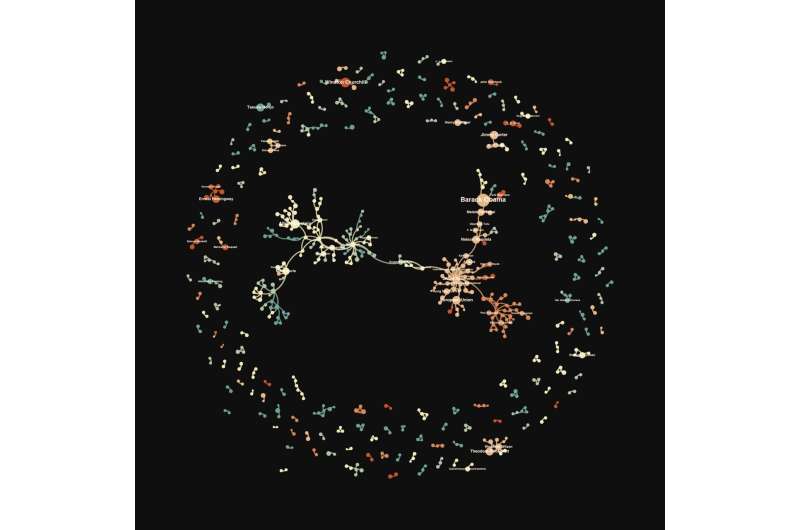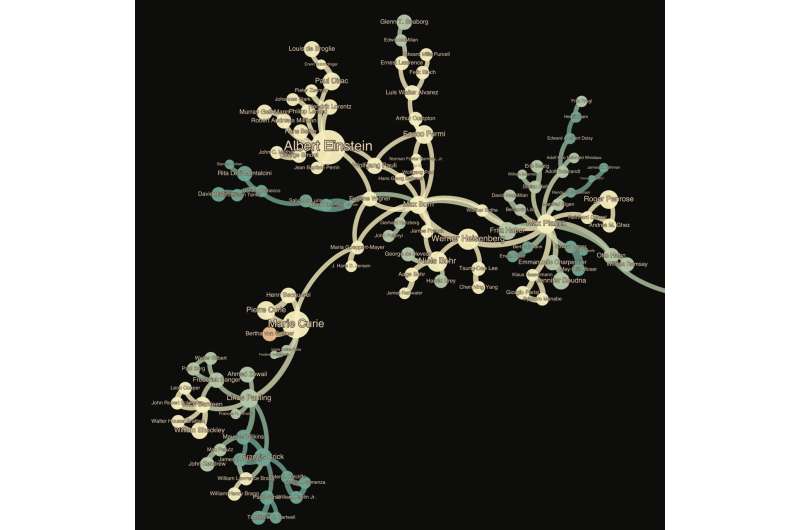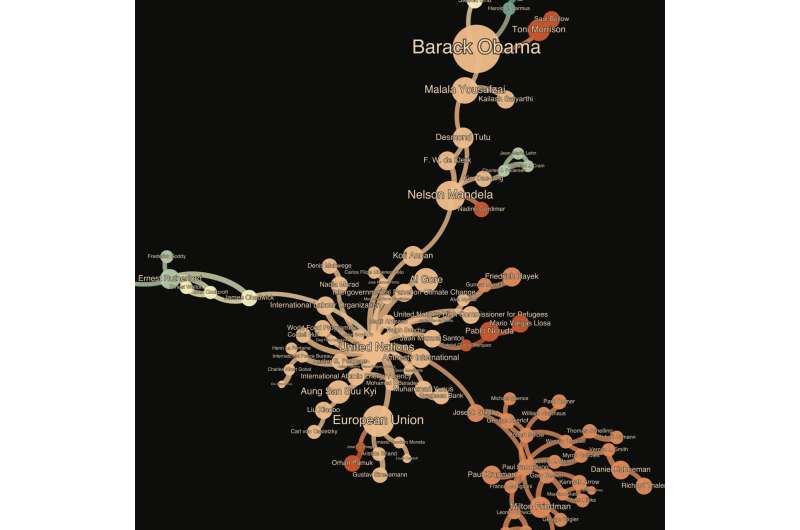October 9, 2023 feature
This article has been reviewed according to Science X's editorial process and policies. Editors have highlighted the following attributes while ensuring the content's credibility:
fact-checked
preprint
trusted source
proofread
Exploring the connections between Nobel laureates using network science

Network science is the study of the complex relationships and connections underpinning wide datasets, groups of individuals or other systems composed of many interacting parts. This fascinating study of connections can used to create maps and representations of numerous areas of life, ranging from scientific phenomena to social groups and even popular media.
Milán Janosov, network science researcher and chief data scientist at Baoba, has been exploring the links underpinning countless everyday networks, novels, TV series and social groups. In one of his most recent papers, pre-published on arXiv, he maps the connections between the brilliant minds that attained Nobel prizes over the years.
"As a network scientist, I seek these hidden connections and patterns behind literally anything I come across," Janosov said. "The trigger for this particular study was a documentary I watched about Einstein's life, which made me realize how many of that era's most famous were friends or worked together, so I started to wonder if this is also visible in the data, and whether this close clustering still holds at later times as well. Shortly, I wanted to figure out how well-connected Nobel laurates are."
The primary objective of Janosov's recent work was to better understand how Nobel laureates from the past were socially connected to each other. To do this, he first had to gather data related to Nobel laureates that also mentioned their connections to others who also received a Nobel Prize.
"The logic behind the study was pretty simple, and for anyone experienced in Python programming, the technical part would be so, as well," Janosov explained. "First of all, I needed data sources. While mapping the social network of people living today can be straightforward, connecting scientists going back to a century might get trickier, as we can't ask them to fill out a survey. However, as they are famous, widely acknowledged people, most of them have Wikipedia pages, and that is all a data scientist needs."

Janosov thus set out to gather information about Nobel laureates from their Wikipedia pages, as these pages often mention other famous people they were either socially or professionally connected to, as well as hyperlinks leading to these scientists' or thinkers' Wikipedia pages. Collectively, he analyzed the Wikipedia pages of 682 Nobel laureates using data science tools and was able to visually map the social connections between these laureates.
"if we take closer look at, for instance, Einstein's Wiki page and start reading his life story, we will notice that every time he had some business with another Wiki-famous person, that person is mentioned, and his/her Wiki site is linked," Janosov said. "This reference is exactly what I was looking for—a way to formalize the relationship between two Nobel laureates based on whether they knew each other."
The data analyses carried out by Janosov yielded interesting results, suggesting that many Nobel laureates were in fact in some way socially connected to each other. The researcher created a visual map representing the relationships between Nobel laureates, which consisted of 682 nodes (i.e., dots), and 588 connections between these nodes (representing connections between the laureates).
"The most striking feature of the network graph is its strong so-called core-periphery structure," Janosov explained. "This means that in the center, there is a large, connected, widely interlinked component that contains more than 30% of the nodes. Additionally, it turned out that those located at the center of the network have—on average—twice as many views on Wikipedia, so they are both centered in their own world and the public eye."
Interestingly, the central component of the visual map created by Janosov is what is known as a bi-modal network. This is basically a graph that is made up of two pronounced halves, bridged together by a few nodes, in this case, by a few Nobel laureates.

"From left to the bridge is the cluster of sciences—like Physics, Chemistry, and Physiology," Janosov said. "The biggest names here are Einstein, Heisenberg, Marie Curie, and, from the recent times, Roger Penrose. Contrasting to this, on the right from the bridge are the humanities, such as Economics, literature, and Peace laureates, with pronounced hubs like Nelson Mandela, Barack Obama, and the EU. I think this example shows quite well how data and network science can be used to map out social systems that are, by first impression, hard to trace."
Janosov's recent work demonstrates the huge potential of network science for understanding various relationships, including the social connections between people who are part of a same group or category. His visual map of the Nobel laureate network, for instance, shows that while there are many connections between recipients of Nobel prizes, there appears to be a disparity in the visibility of different laureates. In other words, while some Nobel prize recipients are closely connected to each other, others remain in the network's "outskirts," without being socially linked to most other Nobel laurates.
Janosov's Nobel network also uncovered a clear distinction between those who received prizes for scientific and humanistic work, as Prize recipients for these different disciplines rarely appeared to be socially connected. Finally, his visual map highlighted the underrepresentation of women in some Nobel Prize categories, including Physics.
"This work shows how to spot exciting or unexpected patterns in the structure of a network and how to describe and interpret a network graph," Janosov added. "This sort of relationship analysis has many applications, starting from education and sociograms, teachers can rely on such maps to better organize their classes and help those left behind. We can also use these methods to study and quantify collaboration, from science to workspaces, which leads me to another significant group of applications—data-driven HR and people analytics. In this case, for instance, one may use internal data, such as surveys or emailing, to map out a company's internal structure and identify weak points, and propose development plans."
More information: Milan Janosov, Genius Cliques: Mapping out the Nobel Network, arXiv (2023). DOI: 10.48550/arxiv.2309.15610
© 2023 Science X Network



















